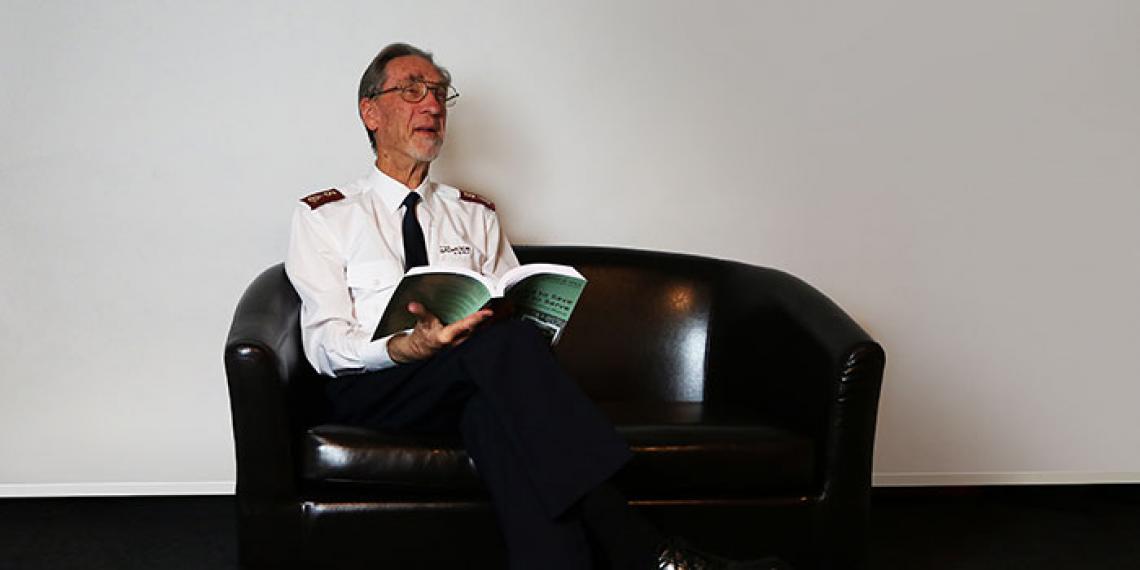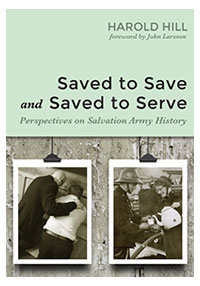You are here
A dangerous mind

Major (Dr) Harold Hill has been described as ‘a radical and a provoker’. His latest book challenges The Salvation Army to look back at our past in order to look forward, and rediscover our radical heart.
Harold Hill’s new book Saved to Save and Saved to Serve is a rare achievement: a textbook that is a genuine page turner. I found myself reading late into the night, ferreting out the gems on every page. It is an eloquently written and balanced history of The Salvation Army—peppered with one-liners that have to be read with a wry smile. For example, Harold concludes that William Booth’s vision of discipleship was never fully realised because ‘by then everyone had joined brass bands instead’.
That’s not to say Harold’s book doesn’t champion The Salvation Army—overall, the impression is of a movement of which we can be immensely proud. Harold produces a respectful and thoughtful history, but a subtle honesty is ever the undercurrent.
Radical Thoughts
Harold has been described as ‘one of the Army’s unique characters … a radical and a provoker,’ by long-time friend Seth Le Leu. When I ask Harold about this, he answers—again that wry smile—with a story from his youth: ‘My wife Pat was warned against marrying me by a senior leader in the Army, saying that I was a dangerous person because I had liberal ideas.’
What were your liberal ideas? ‘I have no idea!’
So, your wife didn’t take their advice? ‘No, thankfully.’
His reputation was, at least in part, established when he was a university student, studying history. Harold became a founder and the editor of the Salvation Army magazine Battlepoint—which quickly became the place where people talked about topics that were taboo within the wider Army. ‘There was nowhere Salvationists could talk and express opinions,’ explains Harold. ‘Some older officers found it very threatening that young people were having opinions about the Army, and not just saluting and going out and saving souls.
‘There was also a huge suspicion of students and it was thought they were having radical thoughts, and were dangerous and critical.’ This was the 1960s —when the rest of the Western World was living through the sexual revolution. In response, evangelical Christianity generally developed a suspicion of intellectualism and bohemian student life.
If Harold was a ‘radical’, he was also very much a Salvation Army insider. Growing up as the child of officers, he always sensed that this would also be his path. Harold trained as a teacher, and Pat as a doctor. But by 1970, they felt that it was time to throw their hats (and bonnets) into the ring and become Salvation Army officers.
Battlepoint continued to run for 25 years, long after most other contemporary independent Salvation Army publications folded. It came out of the Army’s student fellowship—a lively gathering of Salvationist students. The forward-thinking Commissioner Alfred Gilliard refused to give the student body a constitution, sensing that would be its death knell.
‘But when a later commissioner arrived in 1971, he organised a constitution for the Student’s Fellowship, which then didn’t last much longer,’ Harold recalls.
This tension between innovation and institutionalisation is one of the fascinating themes of Harold’s book.
Our people
Of William Booth, George Scott Railton wrote, ‘he always advocated for an organisation so open to all, and a system so elastic, that zeal might never be repressed, but only made the most of.’
Harold describes the fledging Salvation Army as the ‘age of enthusiasm’. This was when open-air meetings were loud and outlandish, brass bands were introduced to drown out the noise of rabble rousers; the Army was made up of ‘inebriates’, ‘labouring people and roughs’; and ‘free and easy’ meetings followed the patterns of the music hall. In short, the early Army was uncouth. And as Booth famously said to his son, ‘These are our people!’
But by 1900, innovations were already becoming tradition. ‘The first generation had the miracle of changing beer into furniture,’ says Harold. But within a couple of generations they had changed furniture into middle-class respectability. This affected ‘what the gentrifying second generation Salvationists would tolerate among themselves’.
Harold’s formative years were arguably at the epoch of Salvation Army institutionalism. At times, the Army was becoming the very thing it set out to reject. He says, ‘I recall a Salvationist expressing disquiet at the number of “social cases” beginning to attend her large, traditional corps, saying: “Why don’t these people go to the “goodwill corps” and leave the citadel to us?” ’
Harold and Pat did just that, helping set up a youth service for inner-city kids who were not accepted within the traditional corps, attended by up to 80 young people. ‘For about seven years that was our church, and it was unrecognisable from The Salvation Army elsewhere,’ Harold says.
On some occasions, traditionalism had become faintly ridiculous. Harold recalls that the early Salvation Army in New Zealand held open-air meetings in the slum of Jesse Street, Wellington. By the 1960s, the area had been converted into offices and work blocks, but the band continued to play there before congress witness marches.
‘The reason was that they knew how long it would take to march from there to the Town Hall, so that the various bands would pass the saluting base in correct sequence. And that is why we continued to witness to office buildings in Jesse Street, years after everyone had left’ (wry smile).
Recovering zeal
Yet this is not the end of the story. Since the 1980s, The Salvation Army has renewed efforts to reconnect with its social services and allow for greater diversity. Recovery Churches, Community Ministries and world-class addictions services are stellar examples of The Salvation Army building on its original foundations.
‘We still have people working at the coalface with people who are in real trouble, so we still have the miracle of turning beer into furniture happening now,’ says Harold. ‘Transformations are still happening, and for me that is the justification for The Salvation Army still existing.’
What will it take to once again embrace Booth’s vision for an elastic and zealous movement? ‘The first part is being aware. What we were trying to do with Battlepoint was make people aware. The second thing would be to recover the reason why we were doing something in the first place, and the third thing would be to apply it to the context in which we now live,’ he sums up.
As a passionate historian, Harold is in no way anti-tradition, but urges The Salvation Army to rediscover its true traditions. ‘There are some distinctives that are okay to carry forward,’ he says. ‘In dealing with [tradition] some have thought that our answer is to become like the Pentecostal church down the street, but that is somebody else’s tradition. The answer is not to copy anybody else—and there are parts of tradition that are worth maintaining —but to remember who we really are.’
So who are we, really? Harold sums up The Salvation Army simply as a faith community with a social service focus. ‘There has been a deep divide between “church” and “social”. They were never meant to be driven apart, so that’s part of our DNA we’ve been recovering in recent years, because they belong together.’
Learning from history
The words ‘radical’ and ‘historian’ are not natural bedfellows, but it would be quite accurate to say both of Harold. In summing up the importance of looking back at our past, he tells the story of an old friend who, as a child, was repeatedly getting lost in the New Zealand bush. Eventually he asked an accomplished bushman how to avoid getting lost.
His answer: ‘ “Three things—1. Stop. 2. Look back. 3. Often.” In practical terms, when you look back you see it from a different angle, and it’s the angle you’ll see when you are returning. In general terms, if the church doesn’t want to get lost, it needs to look back often, know where it has come from, and know where it is the in world.
‘We need to look at what we’re doing in terms of what we set out do to. What were we trying to do? And should we be doing that now? Or should we be doing that, but in a different way? We don’t understand the present until we have looked at our past.’
by Ingrid Barratt (c) 'War Cry' magazine, 4 November, pp6-9
You can read 'War Cry' at your nearest Salvation Army church or centre, or subscribe through Salvationist Resources.
Saved to Save and Saved to Serve
Buy in paperback, hard copy or Kindle format from Amazon.com
